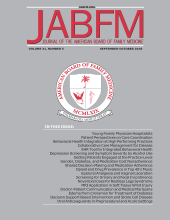Abstract
Purpose: This Maintenance of Certification activity was designed to help address gaps in osteoporosis management, provide practice improvement based on recognized models, and evaluate the impact of the initiative.
Methods: The program comprised 3 stages: stage A, practice self-assessment and chart review; stage B, an intervention to address at least 1 problem; and stage C, additional chart review (new patients). Data from stages A and C were compared to evaluate the impact of the activity.
Results: Of 217 registrants, 62 completed the program, reviewing 2107 and 1814 charts in stages A and C, respectively. Statistically significant improvements occurred in all quality attributes from stage A to stage C in 6 specified domains, except for the proportion of patients with an osteoporosis diagnosis.
Conclusions: Results of this activity support the benefit of performance improvement initiatives and are consistent with other reports.
Mandatory changes in board certification requirements, that is, Maintenance of Certification (MOC), have resulted in quality care and performance improvement initiatives and programs. Published data supporting behavioral changes resulting from such programs are limited. The MOC activity reported here was designed to address gaps in osteoporosis management, provide practice improvement based on recognized models for such activities (eg, the METRIC Diabetes Module offered by the American Academy of Family Physicians),1 and evaluate the impact of the activity in improving practice attributes and adherence to national standards of care. The results of this initiative are presented herein, adding to data demonstrating that this approach can be effective in changing practice.
Methods
This online activity was developed by the Annenberg Center for Health Sciences at Eisenhower Medical Center (Rancho Mirage, CA). The Annenberg Center has been approved by the American Board of Family Medicine for this activity as an external provider of MOC for Family Physicians Part IV credit. The Annenberg Center is also accredited by the Accreditation Council for Continuing Medical Education to provide continuing medical education for physicians. The activity comprised 3 stages. In stage A, physicians assessed practice attributes for 6 domains (such as organization, community linkages, and clinical information systems) and conducted chart reviews to establish their baseline on 4 quality measures derived from the Physicians Consortium for Performance Improvement library of measures and developed from national practice guidelines2 (Table 1). Patients for chart review had to be women aged ≥65 years, men or women aged ≥50 years who had had a fracture of the hip, spine, or distal radius; or men or women aged ≥50 years who had an established diagnosis of osteoporosis. In stage B, participants selected an intervention (prespecified or their own action item) to address at least 1 problem area. After at least 1 month, participants conducted additional chart reviews for a different set of patients meeting the same criteria (stage C) to assess practice and performance changes from stage A. Data from stages A and C were compared.
Results
Of 217 physicians who registered between December 28, 2011, and October 31, 2013, 62 completed stages A, B, and C of the performance improvement module, reviewing 2107 and 1814 charts in stages A and C, respectively. Positive shifts occurred in practice attributes from stage A to stage C across all 6 domains. For example, when assessing the organization of the practice, 66% of the responses in stage A were that the approach to osteoporosis is not systematic. In stage C, that percentage was 39%, a decrease (improvement) of 27 percentage points. Significant improvements occurred in all quality attributes from stage A to stage C, except for the proportion of patients with an osteoporosis diagnosis (Table 1). When results were reanalyzed for each outcome using cluster adjustment to account for physician variation, all comparisons remained significantly different. All differences in outcome variables between stages A and B also remained significant in the multivariate model that adjusted for age, sex, and previous fracture. Participants who evaluated the program rated it highly across all stages. Program ratings on all questions ranged from 4.7 to 5.4, with 6 being the highest and 1 the lowest.
Conclusions
This practice improvement intervention to optimize fracture prevention resulted in significant improvements in all key performance measures other than the percentage of patients receiving a diagnosis of osteoporosis. Results were consistent with other practice improvement initiatives for osteoporosis and other areas of medicine.3⇓–5 Improvements demonstrated in this activity support the benefit of performance improvement initiatives and provide a foundation for ongoing research including associations between performance improvement and health outcomes.
Acknowledgments
Philip A. Dombrowski, MBA, then president and CEO, The Annenberg Center for Health Sciences at Eisenhower Medical Center, Rancho Mirage, CA, was involved in program conceptualization, development, and implementation. Editorial assistance was provided by Paula G. Davis, PhD, Medical Communications, Inc., Tequesta, FL, and Kathleen Major, KMajor Editorial Services, Mahwah, NJ. Statistical analyses were conducted by Martin L. Lee, PhD, CStat, CSci, Adjunct Professor, Biostatistics, UCLA School of Public Health, Los Angeles, CA.
Notes
This article was externally peer reviewed.
Funding: The costs related to the technology platform for the project were supported through an educational donation provided by Amgen (HCCOPS-25223). The Annenberg Center for Health Sciences at Eisenhower Medical Center provided management support and funded the costs of content development.
Conflict of interest: none declared.
- Received for publication February 26, 2015.
- Revision received April 29, 2015.
- Accepted for publication May 4, 2015.







